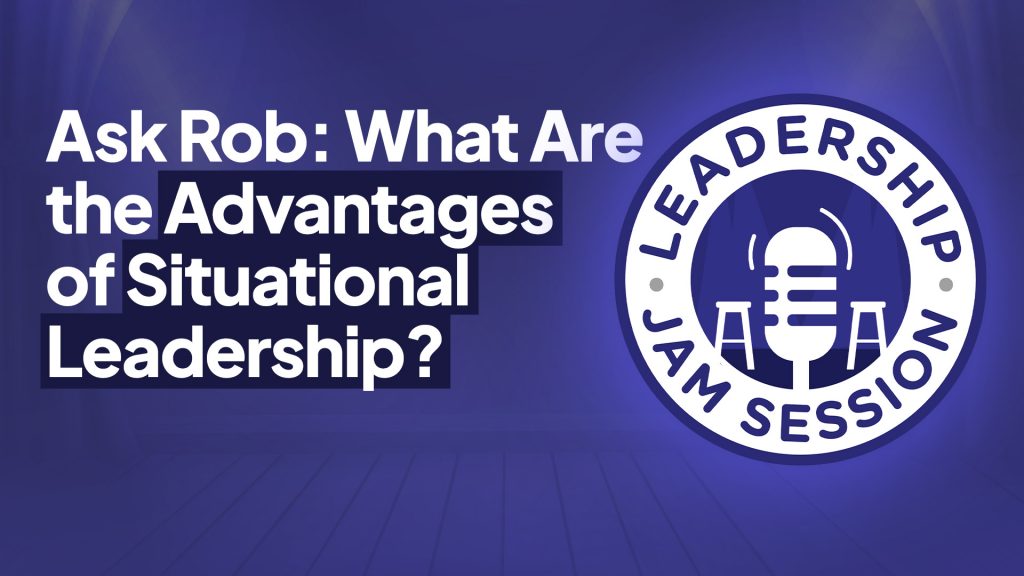Ask Rob: What Are the Advantages of Situational Leadership?

What is situational leadership, and what are some of its benefits?
I’ve always been a big fan of the situational leadership model. To me, it’s the very backbone of leadership, and in today’s ‘Ask Rob’ segment, I explain precisely why.
I break down the model’s four stages and share a few examples of how it works. I also explain why new managers should learn about the situational leadership concept.
Keep reading to learn how you can develop situational leadership skills to become a better leader.
Why the Situational Leadership Model is So Effective
The question I’m tackling today came to me from Sarah, who’s a manager down in Tennessee:
“Hey, Rob, I heard you talk about situational leadership and sounded like you were a fan of it. I’m a newly appointed manager. And I was wondering if that’s a course I should take, or is that reserved for a different level of experience and leadership?”
My answer to Sarah is, ‘Yes, you should definitely go through it. As I mentioned earlier, I love the situational leadership approach. I am a certified trainer in situational leadership and I do teach it.
My company’s leadership group is a channel partner through the Ken Blanchard (the model’s creator) group. So, as distributors, we are allowed to teach it and deliver it to our clients.
I’ve been certified in several different courses over the years; emotional intelligence, strength-based leadership, and many more. There are many great courses out there, but I always come back to situational leadership.
As I mentioned before, for me, this model is the backbone of leadership. It’s an excellent course for new managers, but quite honestly, it applies to any level of leadership.
I coach many leaders at all different levels. Several leadership gaps even experienced leaders have are directly related to a gap in situational leadership. So, I believe the model is a must for all managers who want to hone their leadership skills.
Let’s take a high-level walkthrough of the model. Hopefully, you’ll have a genuine appreciation of what it has to offer after reading!
The Four Levels of the Situational Leadership Model
The model suggests the idea that there are four different levels that we go through in terms of learning something. And four correlating management skills are aligned to each level.
So, I’ll walk you through the model using a personal example, not related to employees or in the workplace, but actually at home.
I’ll go over the four development levels of situational leadership, telling a story about my twin boys, Oscar and Felix. It happened back when they were learning to ride their bikes without training wheels.
Level 1 – The Enthusiastic Learner (D1)
Felix went through the four levels pretty quickly. In less than an hour, he was riding the bike on his own. On the other hand, Oscar had spent that time cleaning his room, and he had just stepped outside.
Now it was Oscar’s turn. After watching his brother riding his bike effortlessly, he got pretty excited to try it himself. That level of enthusiasm is precisely the first level of situational leadership; the enthusiastic learner.
Level 2 – The Disillusioned Learner (D2)
While trying to ride his bike without training wheels, Oscar quickly moved into the next development level – D2. It’s called ‘The Disillusioned Learner” because Oscar was no longer excited and enthusiastic..
He fell off his bike, so he was starting to get a little bit demotivated. He was on the ground crying, wanting his training wheels back on.
As a learner, you go through this phase where your confidence starts to hit a low when learning something new. And as a manager, you need to provide guidance and direction when you’re helping somebody learn something. It’s your job to give them perspective and encouragement.
So I kneeled next to Oscar and told him that the training wheels were never coming back. If he wanted to learn how to ride his bike, he needed to overcome his fears. It’d take some time, but I promised him he’d eventually get there.
Level 3 – The Capable but Cautious Learner (D3)
It took him a while to get there, but as I stood there working with him and encouraging him, that magic moment happened: I let go of the bike, and all of a sudden, he started to do it on his own.
He was still wobbling and turning around, looking at me as he rode, so I had to tell him to keep his eyes on the road.
That’s a sign of that development level 3: a capable but cautious learner. While they have overcome their initial fears, they still lack some confidence.
Level 4 – The Reliant Achiever (D4)
Before long, with some more encouragement, Oscar was finally able to ride entirely on his own. That’s the final development level: a self-reliant achiever.
Self-reliant achievers have learned how to do something; they’re skilled and competent to do it. With confidence and motivation, they can do it pretty much on their own. That’s when they’ve finally mastered that specific skill.
Why New Managers Should Learn the Situational Leadership Approach
I’m aware the previous example is not workplace-related. However, I’m confident that it perfectly illustrates the fundamentals of the situational leadership model.
Besides, seasoned managers know there are many correlations we can make from managing employees to parenting.
Any employee who is entirely new to a task or skill will invariably go through this model. As a leader, you need to match your leadership style to help them navigate through that learning journey.
Sometimes, you’re going to need to be a little more direct or to teach step-by-step examples. Other times, you’ll need to be a sounding board for your employees, a security blanket for them to find the solutions within themselves.
The mistake many new managers make is to assume that their employees know how to do everything. Even seasoned managers fall into the trap of thinking this way.
So, don’t assume your employees know how to do something they’re learning. You need to be observant and flexible; adapt your leadership style to help them acquire that specific skill.
Finally, managing is a lifelong journey of learning. As managers, we go through this model as learners too. Keeping this in mind will help you understand what your people need when learning a new skill.
Do you have a challenging scenario you’d like to run by me?
Go to https://sartoleadershipgroup.com/leadership-jam-session-podcast/. Click on ‘Ask Rob’ and send your request. I’ll respond with some guidance on your scenario!
Key Takeaways
– What is the situational leadership model? (00:00)
– Why this model is the backbone of leadership (03:26)
– The four levels of the situational leadership model (06:11)
– The mistake all leaders do (12:17)
– Why this model applies to all leaders (12:23)
Leadership Resources
How are the leaders at all levels of management tackling the toughest challenges each day? Learn more at: https://sartoleadershipgroup.com

